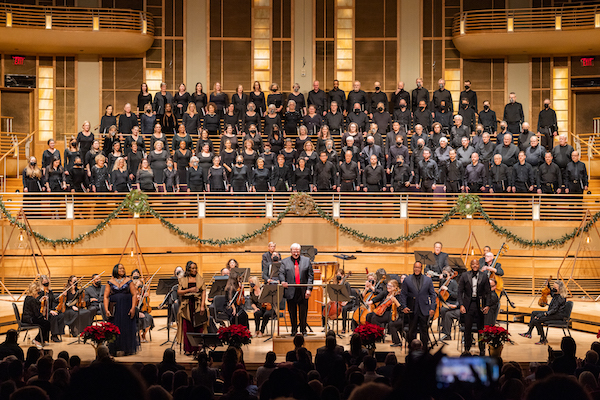After guilt trip intro, National Philharmonic offers worthy singing in a cut and speedy “Messiah”

The National Philharmonic performed Handel’s Messiah Sunday at the Music Center at Strathmore.. Photo: Elman Studio
One of the few good things to come out of the coronavirus pandemic was the chance to reconsider some classical music traditions. No ritual was more ingrained than the annual rounds of Handel’s Messiah every December. The last one published in these virtual pages was back in 2019, a drought ended with Sunday afternoon’s performance by the National Philharmonic in the Music Center at Strathmore.
Some orchestras are questioning whether it makes sense to continue the Messiah tradition, not least because of recent historical scholarship by David Hunter. In 1720, Handel followed the lead of his patron, the Duke of Chandos, by investing in the Royal African Company, the official slave trading enterprise in Britain, led by King George I. Profits from this venture, involving the transport of enslaved people from Africa to English colonies in the Americas, helped fund Handel’s creation of the English oratorio, leading up to the premiere of Messiah in 1742.
Hunter himself has said that he does not feel any differently about performing Messiah, a work that he has sung and always loved. But he has advocated for a sort of “public health warning,” drawing the attention of audiences to the direct connections between Handel and the transatlantic slave trade.
In brief pre-concert remarks, music director Piotr Gajewski did just that, noting that half the proceeds from these Strathmore performances will be donated to the restoration of Montgomery County’s historic Scotland African Methodist Episcopal Zion Church.
Stan Engebretson, who has served as the artistic director of the National Philharmonic Chorale since its inception, then conducted a remarkably concise, fast-moving rendition of this weighty score. With breathless tempi and the omission of ten numbers from Parts II and III, the performance was over in two hours and fifteen minutes, including an intermission.
As announced earlier this fall, Engebretson will step down from his position with the National Philharmonic Chorale after these performances of Messiah. Assistant conductor Rebecca Novak Bryant will take over choir rehearsals and preparation for the rest of the season.
Mezzo-soprano Lucia Bradford dazzled most among the quartet of soloists, with a consistently opulent voice, rich in legato smoothness and reaching from resonant lower reaches to some powerful top notes. On repeat sections in her solos, she added startling ornamentation, all executed with crisp accuracy. Her stellar interpretation of “He was despised” combined luscious musical phrasing and dramatic force.
Alexandria native Kearstin Piper Brown was perhaps not as confident in the soprano solos but displayed remarkable ease in the top register. She added impressive embellishments in her arias, too, including a briskly paced “I know that my redeemer liveth.” Norman Shankle sang running passages with occasional muddiness in the numerous tenor arias, and there was a moment of confusion during “Thy rebuke,” which Engebretson managed to realign.
Baritone Jorell Williams had blustery strength in his top range, adding even more high notes in some of his embellishments, although the bass arias’ periodic low notes paled. His diction was the least clear among the quartet, but his power impressed in the more prophetic pieces. So much so that the audience, which had a tendency to clap before the orchestra completed some arias, ended up clapping twice for his “The trumpet shall sound,” before and after the end.
The National Philharmonic Chorale sounded uneven, with a somewhat anemic soprano and alto sound contrasted with an overly eager tenor section and growling basses. (The great number of viruses in circulation seems to have sidelined a few singers.) Diction was quite clear, but Engebretson’s preparation accented odd tics, like the cutting short of some notes (such as “unto us-” in “For unto us a child is born”) and the introduction of curious staccatos, especially at the ends of longer runs, sounding like ovine bleating in “All we like sheep.”
The orchestra of about thirty musicians had similar struggles, with a few intonation clashes among the cellos and sole bass player.
The resulting performance, although mixed, was occasionally quite good, a sort of halfway approach between historically informed performance (the fleet tempos and copious ornamentation) and modern instruments and large chorus. Christmas trees and evergreen garlands, all illuminated with twinkling lights, set a festive mood, in spite of the heavy historical introduction.
The program will be repeated 7:30 p.m. Friday at Capital One Hall. nationalphilharmonic.org
